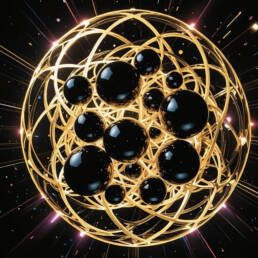Morphic Resonance – New Release with Rupert Sheldrake
Listen to “Morphic Resonance,” the first track from Amalgam Sphere
Mutantrumpeter Ben Neill’s new release “Morphic Resonance” is out now in two distinct versions. This song marks the first release from his album Amalgam Sphere set to unfold over the coming months.
“Morphic Resonance” holds a special significance for Neill, not only for its innovative musical approach but also because it features a collaboration with evolutionary biologist and philosopher Rupert Sheldrake. Sheldrake’s groundbreaking ideas on morphic resonance have had a profound influence on Neill’s thinking since he first encountered them in the early 1990s through a series of conversations between Sheldrake, Terence McKenna, and Ralph Abraham.
Both versions of Morphic Resonance blend the rich, live-sampled textures of Neill’s signature instrument, the Mutantrumpet, with Sheldrake’s voice, processed and transformed into a musical element. The harmonic and melodic structure of the track is built by mapping the letters of the title to musical pitches, creating a sonic embodiment of the concept itself. These sequences trigger the live sampled sounds of Neill’s instrument in real time, creating a distinctly dynamic form of ambient music. The Bifurcated Mix introduces glitchy electronic percussion to the dreamy textures, emphasizing the powerful nature of bifurcation as a creative process.
The concept of morphic resonance suggests that memory is inherent in nature—that natural systems inherit a collective memory from previous similar systems through habitual behavior. This idea deeply resonates with Neill’s own creative philosophy, where patterns and forms emerge from layered, repetitive processes and evolve organically over time. Neill views morphic resonance as a fundamental principle that shapes the way life unfolds and develops.
REVIEWS

Ben Neill’s “Morphic Resonance” is not just a piece of music, but is a philosophical gesture rendered in sound.
Released as a dual version single and marking the final chapter of his forthcoming album “Amalgam Sphere”, the work is deeply informed by the theories of Rupert Sheldrake, the British biologist whose controversial concept of morphic resonance proposes that memory and learning are not confined to the brain but embedded in nature itself.
That Neill chooses to explore this idea not in a lecture hall, but in a dense, immersive soundscape says a great deal about his own creative philosophy. And, the growing porousness between art, science and technology.
Neill, who is perhaps best known as the inventor of the Mutantrumpet, a fantastic shape-shifting hybrid electro-acoustic instrument, has built a decades-long career on this kind of boundary-blurring. Across thirteen albums released on labels like Astralwerks, Six Degrees and Universal’s Verve imprint, Neill’s work has embraced minimalism, ambient electronica, interactive art and jazz, often in the same breath. But Morphic Resonance feels like something new. It is more of a culmination, a synthesis and a provocation.
Central to the track’s construction is Sheldrake’s voice, which Neill doesn’t just sample but transforms into a kind of metaphysical presence. It is at once narrator, texture and spirit guide. Fragments of Sheldrake’s speech drift in and out of the mix, sometimes intelligible, often distorted beyond recognition, suggesting that memory is not a fixed archive but is a vaporous, shape shifting force. The haunt the piece like neural echoes or half remembered dreams.
The sound world that Neill creates around this voice is astonishing in its detail. The original version of the track opens with a delictae interplay of processed trumpet tones and low, glowing drones. Gradually, the sound field thickens, enriched with granulr textures, harmonic overtones, and subtle rhythmic pulses. Rather than moving in a linear arc, the track seems to unfold in spirals and circles back in on itself, expanding and contracting like a breathing organism.
This is music that does not simply develop, but it evolves.
Much of this fluidity comes from the way Neill engages with the Mutantrumpet. With its multiple bells, integrated electronics and gestural control system, it allows for real-time sampling and transformation. The instrument itself is sensitive, reactive and alive. Neill’s use of it here is not virtuosic in the traditional sense; instead, he plays with restraint, allowing the textures and resonances to accumulate organically. The trumpet doesn’t lead so much as it listens.
In a particularly elegant twist, Neill maps the letters in the title “Morphic Resonance” to musical pitches, creating the harmonic and melodic material from linguistic structure itself. It’s a subtle but profound move, echoing Sheldrake’s ideas about the resonance of forms and habits. Language becomes sound. Sound becomes structure. Structure becomes memory. It’s a recursive loop, and Neill navigates it with remarkable sensitivity.
The “Bifurcated Mix” is the second version included in the release, fracturing this dreamlike world with glitchy percussive interventions and sharper electronic edges. If the original mix is memory as mist or sediment, the Bifurcated version is memory under pressure. The introduction of rhythm here turns it into a shifting terrain of broken patterns and flickering signals. It’s less meditative, and more hallucinatory.
This dual presentation is not just a clever production choice—it reflects the underlying philosophy of the piece. For Sheldrake, morphic resonance is about pattern transmission through time: the idea that habits of nature are inherited non-genetically, through fields of information. Neill’s music channels this idea not by describing it, but by embodying it. Patterns are set and then mutated, phrases recur in altered forms, motifs dissolve and are reborn.
“Morphic Resonance” also acts as a sound companion to Neill’s recent book “Diffusing Music: Trajectories of Sonic Democratization”, in which he considers how emerging technologies from AI to algorithmic composition tools, are changing not just how music is participatory, fluid and radically open ended. Neill’s interest lies not in fixed compositions but in adaptive systems where the boundaries between composer, performer and listener begin to blur.
In this light “Morphic Resonance” asks: what if music isn’t just a product of human creativity, but part of a larger ecological and temporal process? What if memory isn’t stored, but acted out? And what if every performance, every iteration is a ghost of what came before, re-shaped by what is happening now?
One gets the feeling that Amalgam Sphere, when fully released, will only deepen these themes. If Morphic Resonance is the seed, the coming work may very well be the bloom – alive, unpredictable and carrying within it the memory of every note that came before.
There’s a moment in Ben Neill’s “Morphic Resonance” where everything seems to fold inwards – Rupert Sheldrake’s softly filtered voice blurs into a grainy echo, a shadow of the sentence before it. The trumpet shimmers, stretches, collapses and reforms. You are not sure if you are moving forwards in time or back. You are not even sure if it matters. This is exactly the point.
With “Morphic Resonance”, Neill, inventor of the Mutantrumpet, composer, sound alchemist- invites us into a space where memory is not something you store but something that you feel happening in real time. The single is the first installment from his forthcoming album “Amalgam Sphere”, and it sets a high bar: intellectually rigorous, emotionally immersive and mesmerizing.
At the center of this piece is the voice of Rupert Sheldrake, the evolutionary biologist whose theory of morphic resonance posits that memory exists in nature as a kind of collective inheritance. His ideas, long on the fringe of mainstream science, are given unexpected intimacy here. Neill doesn’t use Sheldrake’s voice as a lecture. He treats it like weather, like a ghost almost. The words drift through the music as textures and tones, processed into near-melody or dissolving entirely into the digital mist.
This is Neill’s great talent: transformation without erasure. A trumpet becomes a synthesizer. A spoken phrase becomes a chord. A theory becomes a feeling.
The Mutantrumpet, Neill’s custom-built electro-acoustic horn, is both the engine and the palette. With it, he triggers samples, manipulates sounds in real-time and brings in trumpet tones that veer between glowing warmth and something more metallic, and alien almost. He’s not playing on top of electronics but is inside them, or they inside him. You can hear the breath but you also hear the algorithm.
And while the conceptual framework is bold, the track never gets lost in its own ideas. It flows. The textures swell and recede, the harmonies spiral upward, and time feels malleable. In the original mix, Neill builds a sound world that is both minimal and lush – think Harold Budd on a slow descent into a quantum field.
In the “Bifurcated Mix”, glitchy percussion is introduced like a flickering thought giving the music a nervous system and a pulse that skips and stutters.
If all this sounds a bit heady, it it. But not in a way that alienates. There’s a softness to “Morphic Resonance”, a human core. It may be about morphogenetic fields and emergent systems, but it’s also about the way a sound can remind you of something you’ve never heard before. It’s about how music, like memory, doesn’t need to be linear to be true.
Neill’s recent book “Diffusing Music” explores similar terrain – how artists and audiences navigate the explosion of content and technology that’s re-shaping the musical landscape. But this track does something more primal and bypasses the commentary. This is music as mirror neuron, as living archive.
For longtime fans of Neill’s work – stretching back to Triptycal or Green Machine – this release will feel like both a continuation and a new frontier.
For newcomers, “Morphic Resonance” is a perfect entry point that invites presence. It asks what sound can do. It asks what sound can remember.
